Management and Operations: Leadership and Management Roles Report
VerifiedAdded on 2020/01/23
|19
|5424
|184
Report
AI Summary
This report delves into the distinct roles and characteristics of leaders and managers, providing a comparative analysis of their responsibilities within an organizational context. It examines the practical application of leadership and management functions through real-world examples, exploring how leaders and managers navigate various situations within their organizations. The report applies leadership theories and models, including situational, systems, and contingency leadership, to specific scenarios, analyzing their strengths and weaknesses. Furthermore, it explores key approaches to operations management, emphasizing the importance of effective operations in achieving business objectives and assesses the factors that influence operational decision-making. The report also evaluates how leaders and managers can improve operational efficiencies to meet business goals and analyzes the impact of various factors on the business environment and the wider community. Finally, the report provides a critical evaluation of the application of operations management within the context of the organization.
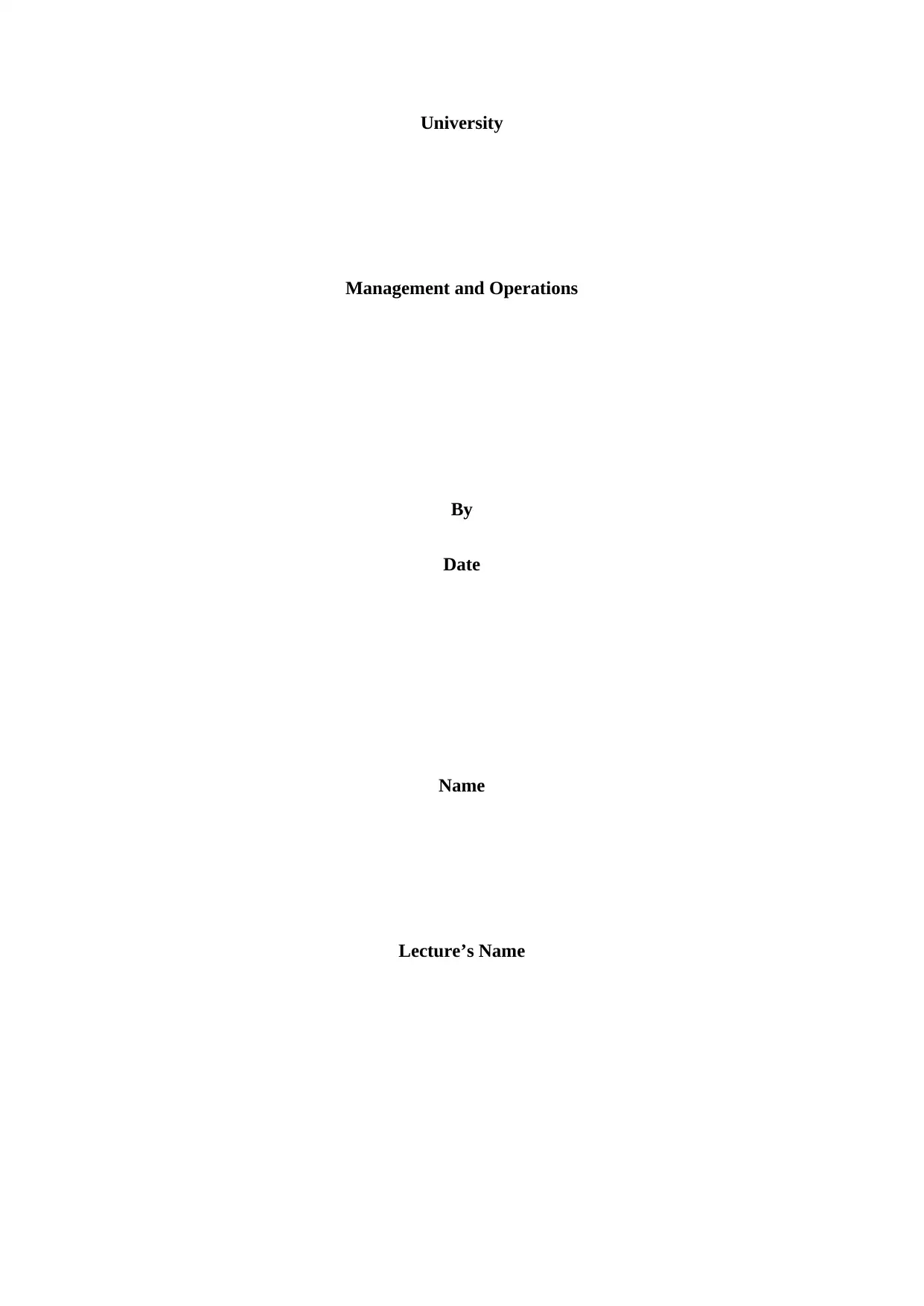
University
Management and Operations
By
Date
Name
Lecture’s Name
Management and Operations
By
Date
Name
Lecture’s Name
Paraphrase This Document
Need a fresh take? Get an instant paraphrase of this document with our AI Paraphraser
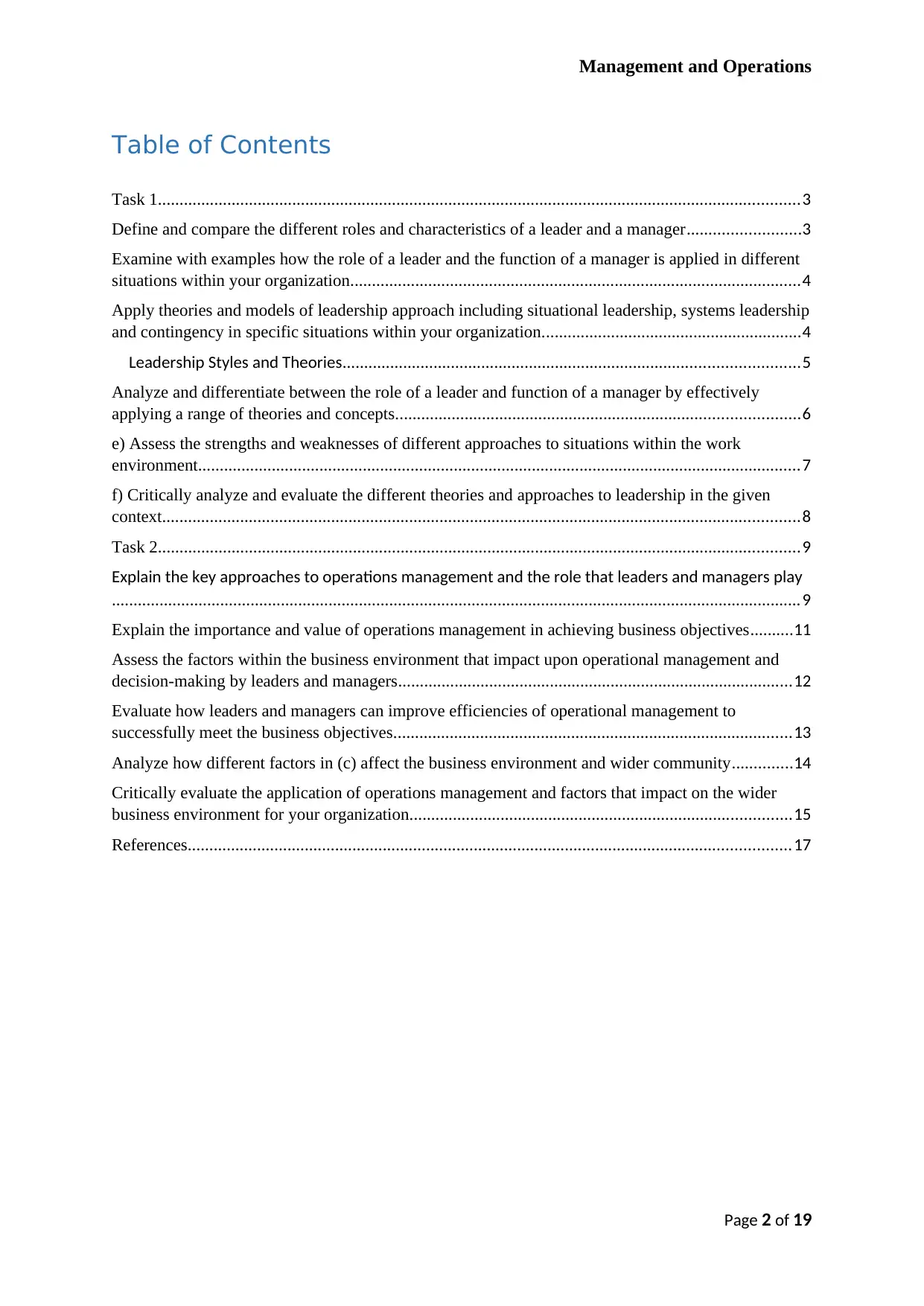
Management and Operations
Table of Contents
Task 1....................................................................................................................................................3
Define and compare the different roles and characteristics of a leader and a manager..........................3
Examine with examples how the role of a leader and the function of a manager is applied in different
situations within your organization........................................................................................................4
Apply theories and models of leadership approach including situational leadership, systems leadership
and contingency in specific situations within your organization............................................................4
Leadership Styles and Theories.........................................................................................................5
Analyze and differentiate between the role of a leader and function of a manager by effectively
applying a range of theories and concepts.............................................................................................6
e) Assess the strengths and weaknesses of different approaches to situations within the work
environment...........................................................................................................................................7
f) Critically analyze and evaluate the different theories and approaches to leadership in the given
context...................................................................................................................................................8
Task 2....................................................................................................................................................9
Explain the key approaches to operations management and the role that leaders and managers play
...............................................................................................................................................................9
Explain the importance and value of operations management in achieving business objectives..........11
Assess the factors within the business environment that impact upon operational management and
decision-making by leaders and managers...........................................................................................12
Evaluate how leaders and managers can improve efficiencies of operational management to
successfully meet the business objectives............................................................................................13
Analyze how different factors in (c) affect the business environment and wider community..............14
Critically evaluate the application of operations management and factors that impact on the wider
business environment for your organization........................................................................................15
References...........................................................................................................................................17
Page 2 of 19
Table of Contents
Task 1....................................................................................................................................................3
Define and compare the different roles and characteristics of a leader and a manager..........................3
Examine with examples how the role of a leader and the function of a manager is applied in different
situations within your organization........................................................................................................4
Apply theories and models of leadership approach including situational leadership, systems leadership
and contingency in specific situations within your organization............................................................4
Leadership Styles and Theories.........................................................................................................5
Analyze and differentiate between the role of a leader and function of a manager by effectively
applying a range of theories and concepts.............................................................................................6
e) Assess the strengths and weaknesses of different approaches to situations within the work
environment...........................................................................................................................................7
f) Critically analyze and evaluate the different theories and approaches to leadership in the given
context...................................................................................................................................................8
Task 2....................................................................................................................................................9
Explain the key approaches to operations management and the role that leaders and managers play
...............................................................................................................................................................9
Explain the importance and value of operations management in achieving business objectives..........11
Assess the factors within the business environment that impact upon operational management and
decision-making by leaders and managers...........................................................................................12
Evaluate how leaders and managers can improve efficiencies of operational management to
successfully meet the business objectives............................................................................................13
Analyze how different factors in (c) affect the business environment and wider community..............14
Critically evaluate the application of operations management and factors that impact on the wider
business environment for your organization........................................................................................15
References...........................................................................................................................................17
Page 2 of 19
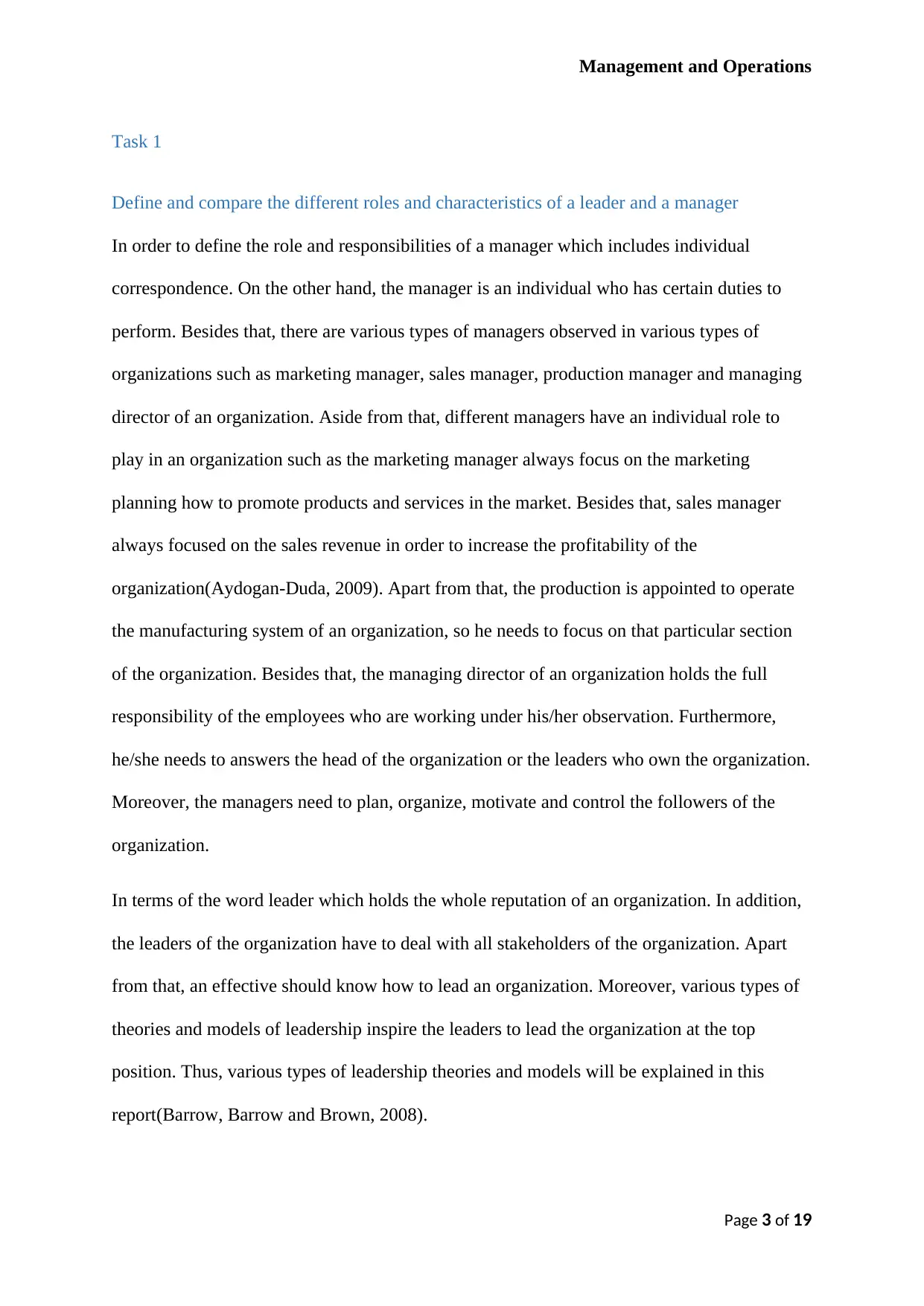
Management and Operations
Task 1
Define and compare the different roles and characteristics of a leader and a manager
In order to define the role and responsibilities of a manager which includes individual
correspondence. On the other hand, the manager is an individual who has certain duties to
perform. Besides that, there are various types of managers observed in various types of
organizations such as marketing manager, sales manager, production manager and managing
director of an organization. Aside from that, different managers have an individual role to
play in an organization such as the marketing manager always focus on the marketing
planning how to promote products and services in the market. Besides that, sales manager
always focused on the sales revenue in order to increase the profitability of the
organization(Aydogan-Duda, 2009). Apart from that, the production is appointed to operate
the manufacturing system of an organization, so he needs to focus on that particular section
of the organization. Besides that, the managing director of an organization holds the full
responsibility of the employees who are working under his/her observation. Furthermore,
he/she needs to answers the head of the organization or the leaders who own the organization.
Moreover, the managers need to plan, organize, motivate and control the followers of the
organization.
In terms of the word leader which holds the whole reputation of an organization. In addition,
the leaders of the organization have to deal with all stakeholders of the organization. Apart
from that, an effective should know how to lead an organization. Moreover, various types of
theories and models of leadership inspire the leaders to lead the organization at the top
position. Thus, various types of leadership theories and models will be explained in this
report(Barrow, Barrow and Brown, 2008).
Page 3 of 19
Task 1
Define and compare the different roles and characteristics of a leader and a manager
In order to define the role and responsibilities of a manager which includes individual
correspondence. On the other hand, the manager is an individual who has certain duties to
perform. Besides that, there are various types of managers observed in various types of
organizations such as marketing manager, sales manager, production manager and managing
director of an organization. Aside from that, different managers have an individual role to
play in an organization such as the marketing manager always focus on the marketing
planning how to promote products and services in the market. Besides that, sales manager
always focused on the sales revenue in order to increase the profitability of the
organization(Aydogan-Duda, 2009). Apart from that, the production is appointed to operate
the manufacturing system of an organization, so he needs to focus on that particular section
of the organization. Besides that, the managing director of an organization holds the full
responsibility of the employees who are working under his/her observation. Furthermore,
he/she needs to answers the head of the organization or the leaders who own the organization.
Moreover, the managers need to plan, organize, motivate and control the followers of the
organization.
In terms of the word leader which holds the whole reputation of an organization. In addition,
the leaders of the organization have to deal with all stakeholders of the organization. Apart
from that, an effective should know how to lead an organization. Moreover, various types of
theories and models of leadership inspire the leaders to lead the organization at the top
position. Thus, various types of leadership theories and models will be explained in this
report(Barrow, Barrow and Brown, 2008).
Page 3 of 19
⊘ This is a preview!⊘
Do you want full access?
Subscribe today to unlock all pages.

Trusted by 1+ million students worldwide
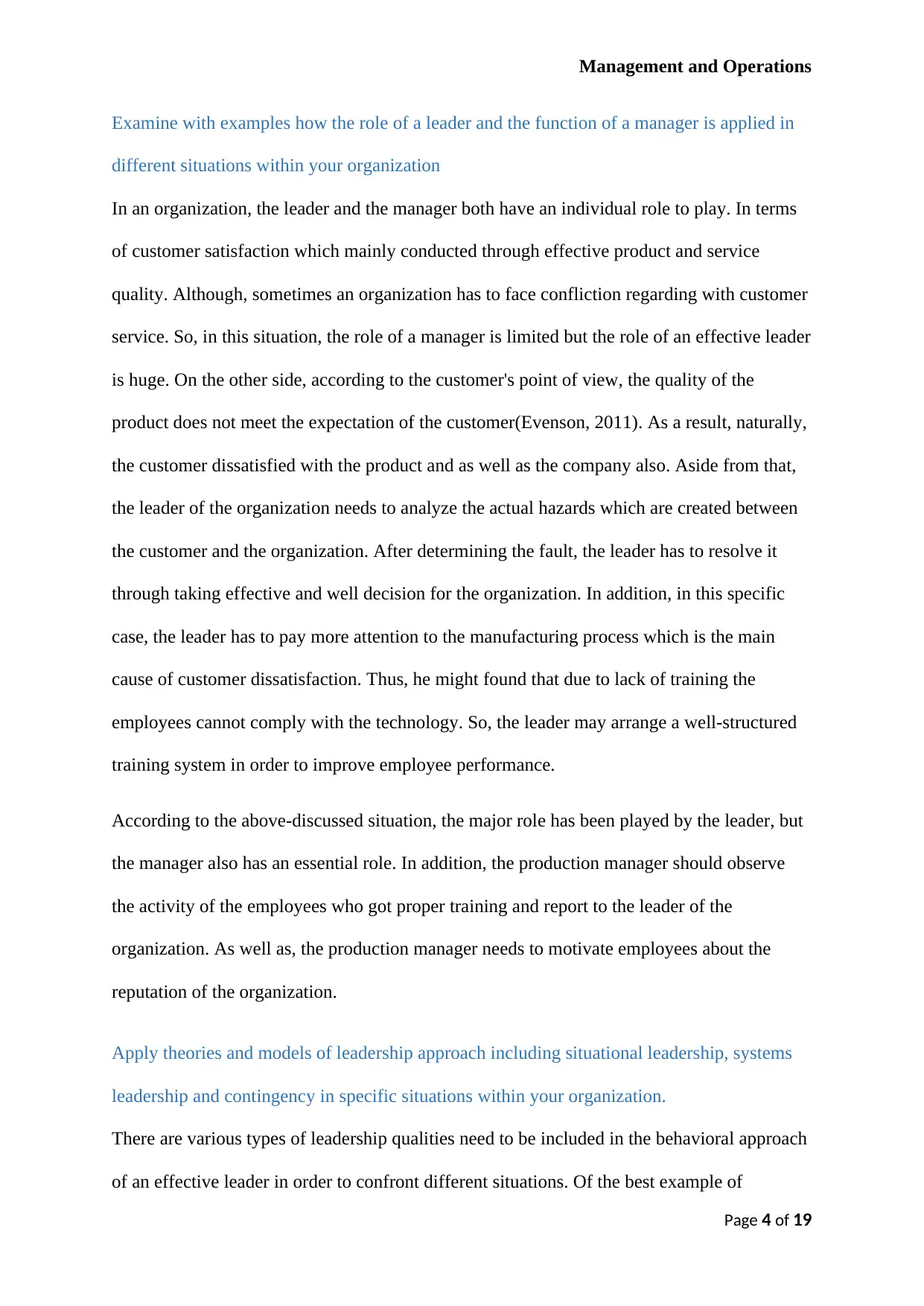
Management and Operations
Examine with examples how the role of a leader and the function of a manager is applied in
different situations within your organization
In an organization, the leader and the manager both have an individual role to play. In terms
of customer satisfaction which mainly conducted through effective product and service
quality. Although, sometimes an organization has to face confliction regarding with customer
service. So, in this situation, the role of a manager is limited but the role of an effective leader
is huge. On the other side, according to the customer's point of view, the quality of the
product does not meet the expectation of the customer(Evenson, 2011). As a result, naturally,
the customer dissatisfied with the product and as well as the company also. Aside from that,
the leader of the organization needs to analyze the actual hazards which are created between
the customer and the organization. After determining the fault, the leader has to resolve it
through taking effective and well decision for the organization. In addition, in this specific
case, the leader has to pay more attention to the manufacturing process which is the main
cause of customer dissatisfaction. Thus, he might found that due to lack of training the
employees cannot comply with the technology. So, the leader may arrange a well-structured
training system in order to improve employee performance.
According to the above-discussed situation, the major role has been played by the leader, but
the manager also has an essential role. In addition, the production manager should observe
the activity of the employees who got proper training and report to the leader of the
organization. As well as, the production manager needs to motivate employees about the
reputation of the organization.
Apply theories and models of leadership approach including situational leadership, systems
leadership and contingency in specific situations within your organization.
There are various types of leadership qualities need to be included in the behavioral approach
of an effective leader in order to confront different situations. Of the best example of
Page 4 of 19
Examine with examples how the role of a leader and the function of a manager is applied in
different situations within your organization
In an organization, the leader and the manager both have an individual role to play. In terms
of customer satisfaction which mainly conducted through effective product and service
quality. Although, sometimes an organization has to face confliction regarding with customer
service. So, in this situation, the role of a manager is limited but the role of an effective leader
is huge. On the other side, according to the customer's point of view, the quality of the
product does not meet the expectation of the customer(Evenson, 2011). As a result, naturally,
the customer dissatisfied with the product and as well as the company also. Aside from that,
the leader of the organization needs to analyze the actual hazards which are created between
the customer and the organization. After determining the fault, the leader has to resolve it
through taking effective and well decision for the organization. In addition, in this specific
case, the leader has to pay more attention to the manufacturing process which is the main
cause of customer dissatisfaction. Thus, he might found that due to lack of training the
employees cannot comply with the technology. So, the leader may arrange a well-structured
training system in order to improve employee performance.
According to the above-discussed situation, the major role has been played by the leader, but
the manager also has an essential role. In addition, the production manager should observe
the activity of the employees who got proper training and report to the leader of the
organization. As well as, the production manager needs to motivate employees about the
reputation of the organization.
Apply theories and models of leadership approach including situational leadership, systems
leadership and contingency in specific situations within your organization.
There are various types of leadership qualities need to be included in the behavioral approach
of an effective leader in order to confront different situations. Of the best example of
Page 4 of 19
Paraphrase This Document
Need a fresh take? Get an instant paraphrase of this document with our AI Paraphraser
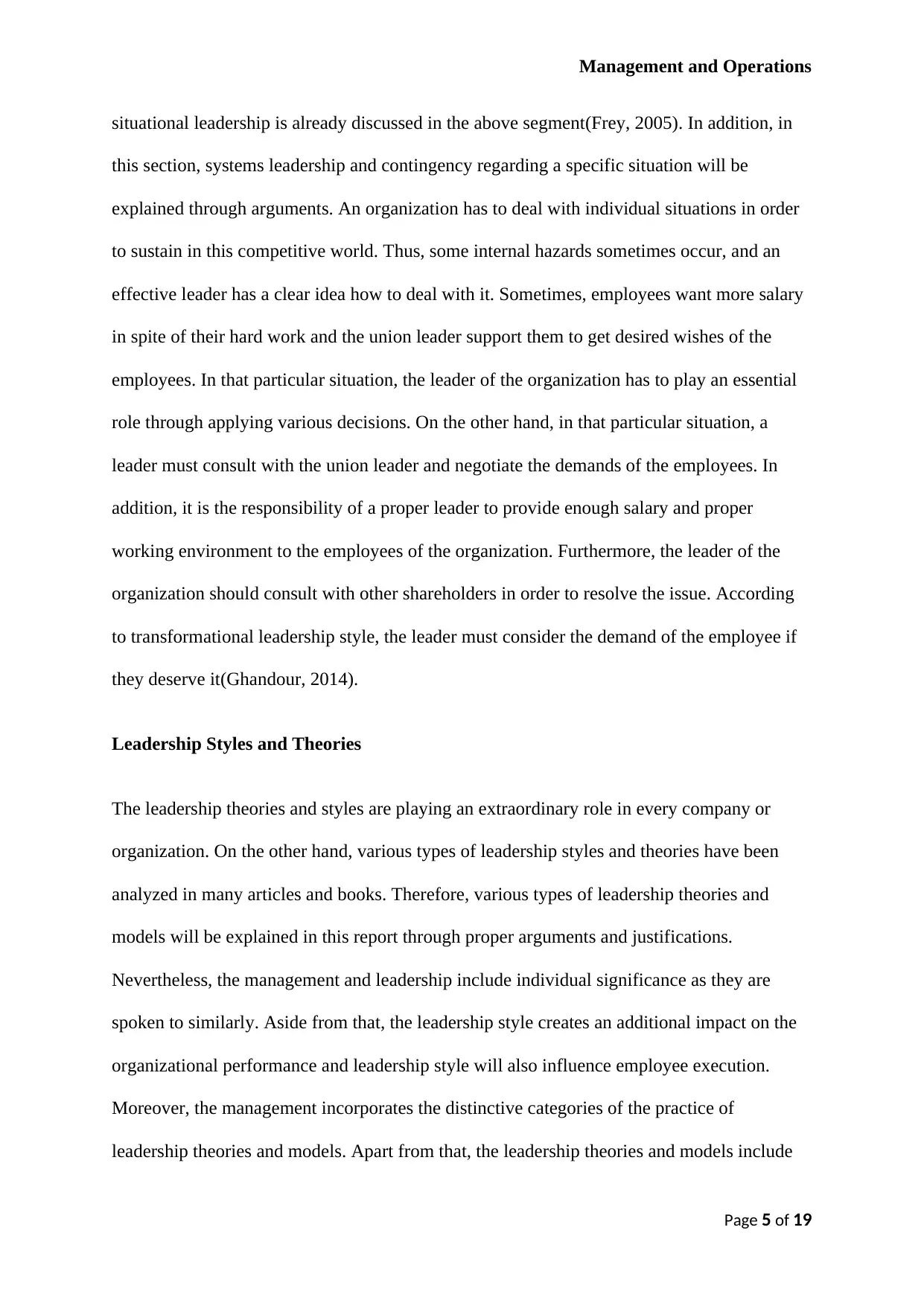
Management and Operations
situational leadership is already discussed in the above segment(Frey, 2005). In addition, in
this section, systems leadership and contingency regarding a specific situation will be
explained through arguments. An organization has to deal with individual situations in order
to sustain in this competitive world. Thus, some internal hazards sometimes occur, and an
effective leader has a clear idea how to deal with it. Sometimes, employees want more salary
in spite of their hard work and the union leader support them to get desired wishes of the
employees. In that particular situation, the leader of the organization has to play an essential
role through applying various decisions. On the other hand, in that particular situation, a
leader must consult with the union leader and negotiate the demands of the employees. In
addition, it is the responsibility of a proper leader to provide enough salary and proper
working environment to the employees of the organization. Furthermore, the leader of the
organization should consult with other shareholders in order to resolve the issue. According
to transformational leadership style, the leader must consider the demand of the employee if
they deserve it(Ghandour, 2014).
Leadership Styles and Theories
The leadership theories and styles are playing an extraordinary role in every company or
organization. On the other hand, various types of leadership styles and theories have been
analyzed in many articles and books. Therefore, various types of leadership theories and
models will be explained in this report through proper arguments and justifications.
Nevertheless, the management and leadership include individual significance as they are
spoken to similarly. Aside from that, the leadership style creates an additional impact on the
organizational performance and leadership style will also influence employee execution.
Moreover, the management incorporates the distinctive categories of the practice of
leadership theories and models. Apart from that, the leadership theories and models include
Page 5 of 19
situational leadership is already discussed in the above segment(Frey, 2005). In addition, in
this section, systems leadership and contingency regarding a specific situation will be
explained through arguments. An organization has to deal with individual situations in order
to sustain in this competitive world. Thus, some internal hazards sometimes occur, and an
effective leader has a clear idea how to deal with it. Sometimes, employees want more salary
in spite of their hard work and the union leader support them to get desired wishes of the
employees. In that particular situation, the leader of the organization has to play an essential
role through applying various decisions. On the other hand, in that particular situation, a
leader must consult with the union leader and negotiate the demands of the employees. In
addition, it is the responsibility of a proper leader to provide enough salary and proper
working environment to the employees of the organization. Furthermore, the leader of the
organization should consult with other shareholders in order to resolve the issue. According
to transformational leadership style, the leader must consider the demand of the employee if
they deserve it(Ghandour, 2014).
Leadership Styles and Theories
The leadership theories and styles are playing an extraordinary role in every company or
organization. On the other hand, various types of leadership styles and theories have been
analyzed in many articles and books. Therefore, various types of leadership theories and
models will be explained in this report through proper arguments and justifications.
Nevertheless, the management and leadership include individual significance as they are
spoken to similarly. Aside from that, the leadership style creates an additional impact on the
organizational performance and leadership style will also influence employee execution.
Moreover, the management incorporates the distinctive categories of the practice of
leadership theories and models. Apart from that, the leadership theories and models include
Page 5 of 19
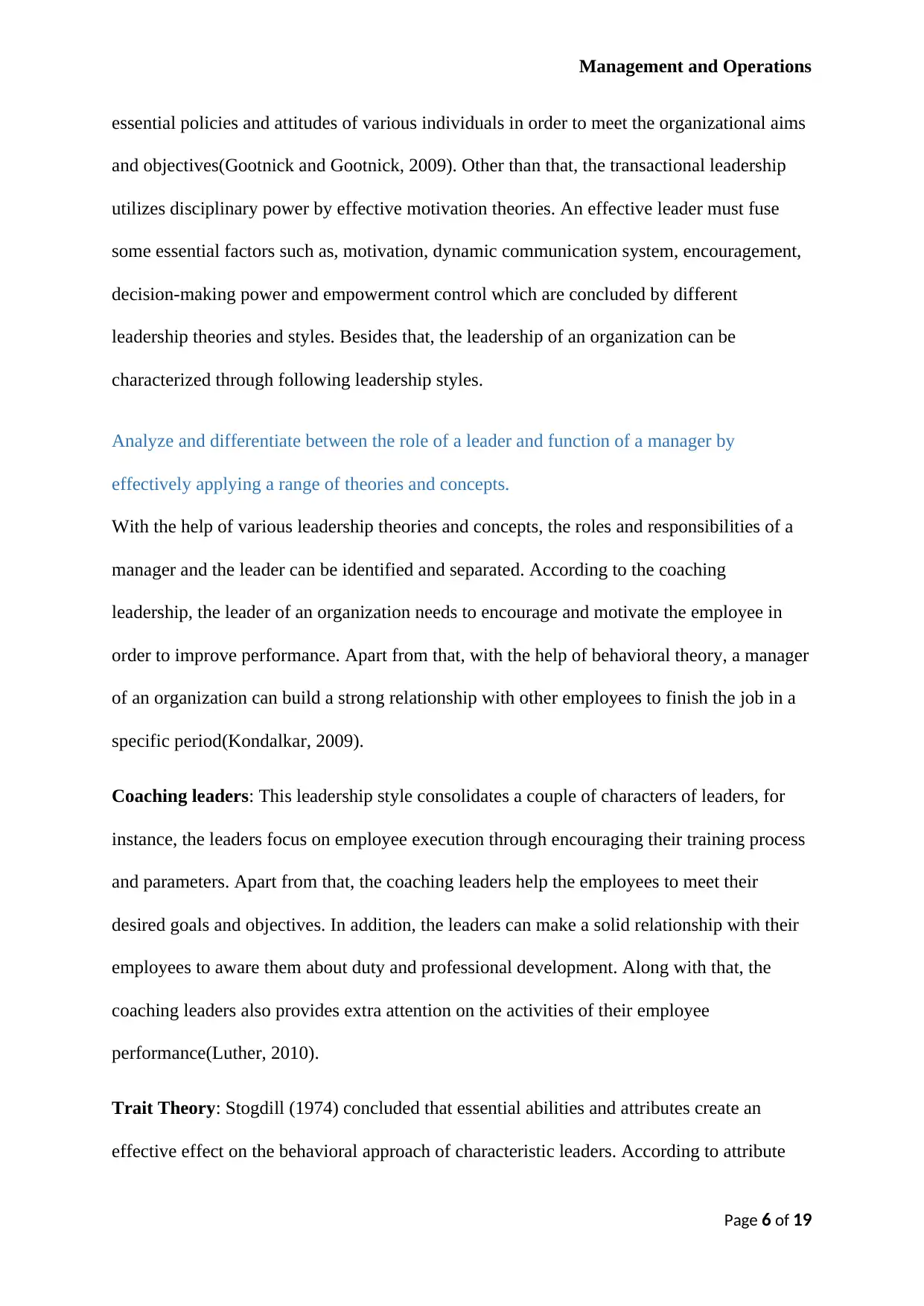
Management and Operations
essential policies and attitudes of various individuals in order to meet the organizational aims
and objectives(Gootnick and Gootnick, 2009). Other than that, the transactional leadership
utilizes disciplinary power by effective motivation theories. An effective leader must fuse
some essential factors such as, motivation, dynamic communication system, encouragement,
decision-making power and empowerment control which are concluded by different
leadership theories and styles. Besides that, the leadership of an organization can be
characterized through following leadership styles.
Analyze and differentiate between the role of a leader and function of a manager by
effectively applying a range of theories and concepts.
With the help of various leadership theories and concepts, the roles and responsibilities of a
manager and the leader can be identified and separated. According to the coaching
leadership, the leader of an organization needs to encourage and motivate the employee in
order to improve performance. Apart from that, with the help of behavioral theory, a manager
of an organization can build a strong relationship with other employees to finish the job in a
specific period(Kondalkar, 2009).
Coaching leaders: This leadership style consolidates a couple of characters of leaders, for
instance, the leaders focus on employee execution through encouraging their training process
and parameters. Apart from that, the coaching leaders help the employees to meet their
desired goals and objectives. In addition, the leaders can make a solid relationship with their
employees to aware them about duty and professional development. Along with that, the
coaching leaders also provides extra attention on the activities of their employee
performance(Luther, 2010).
Trait Theory: Stogdill (1974) concluded that essential abilities and attributes create an
effective effect on the behavioral approach of characteristic leaders. According to attribute
Page 6 of 19
essential policies and attitudes of various individuals in order to meet the organizational aims
and objectives(Gootnick and Gootnick, 2009). Other than that, the transactional leadership
utilizes disciplinary power by effective motivation theories. An effective leader must fuse
some essential factors such as, motivation, dynamic communication system, encouragement,
decision-making power and empowerment control which are concluded by different
leadership theories and styles. Besides that, the leadership of an organization can be
characterized through following leadership styles.
Analyze and differentiate between the role of a leader and function of a manager by
effectively applying a range of theories and concepts.
With the help of various leadership theories and concepts, the roles and responsibilities of a
manager and the leader can be identified and separated. According to the coaching
leadership, the leader of an organization needs to encourage and motivate the employee in
order to improve performance. Apart from that, with the help of behavioral theory, a manager
of an organization can build a strong relationship with other employees to finish the job in a
specific period(Kondalkar, 2009).
Coaching leaders: This leadership style consolidates a couple of characters of leaders, for
instance, the leaders focus on employee execution through encouraging their training process
and parameters. Apart from that, the coaching leaders help the employees to meet their
desired goals and objectives. In addition, the leaders can make a solid relationship with their
employees to aware them about duty and professional development. Along with that, the
coaching leaders also provides extra attention on the activities of their employee
performance(Luther, 2010).
Trait Theory: Stogdill (1974) concluded that essential abilities and attributes create an
effective effect on the behavioral approach of characteristic leaders. According to attribute
Page 6 of 19
⊘ This is a preview!⊘
Do you want full access?
Subscribe today to unlock all pages.

Trusted by 1+ million students worldwide
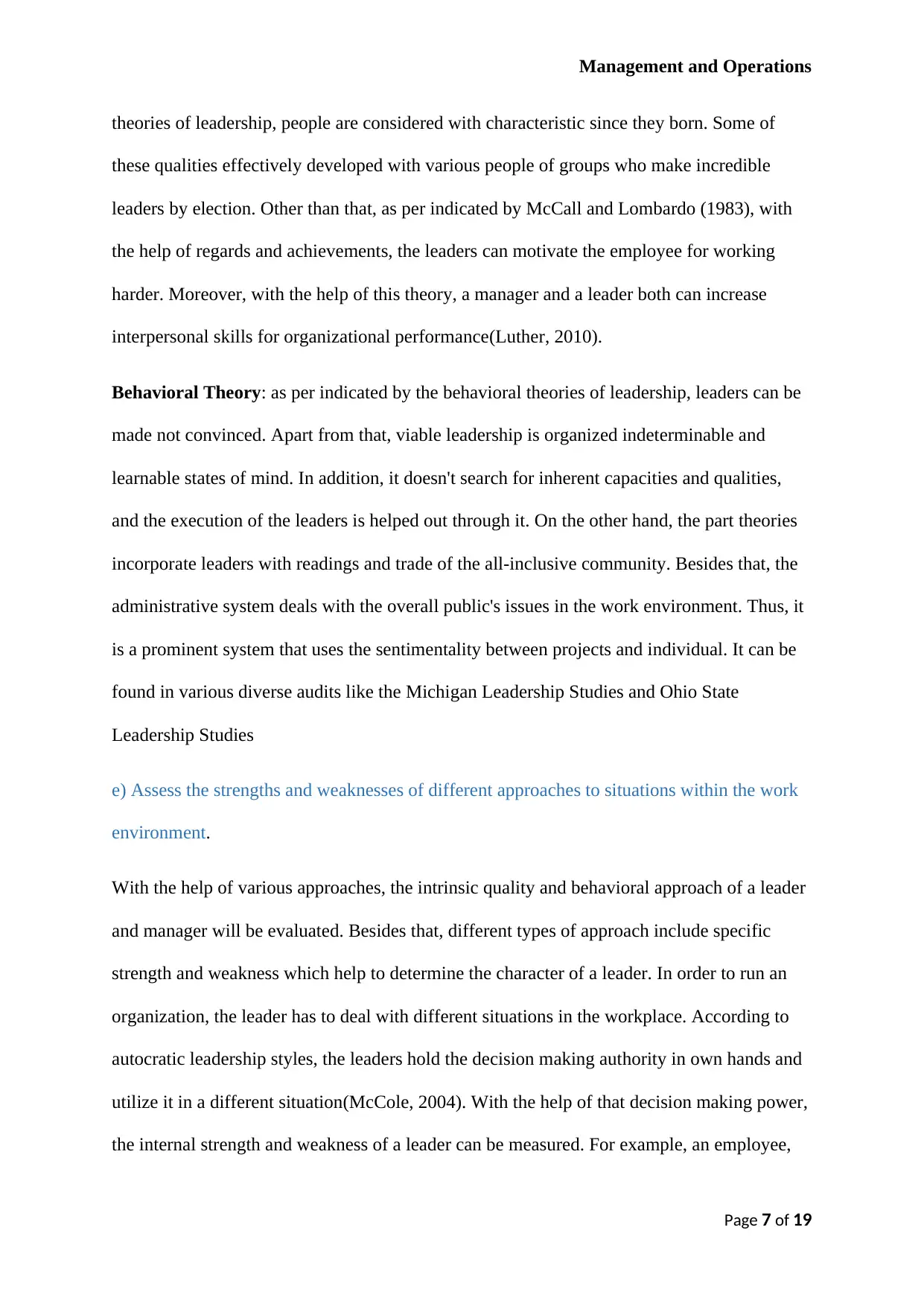
Management and Operations
theories of leadership, people are considered with characteristic since they born. Some of
these qualities effectively developed with various people of groups who make incredible
leaders by election. Other than that, as per indicated by McCall and Lombardo (1983), with
the help of regards and achievements, the leaders can motivate the employee for working
harder. Moreover, with the help of this theory, a manager and a leader both can increase
interpersonal skills for organizational performance(Luther, 2010).
Behavioral Theory: as per indicated by the behavioral theories of leadership, leaders can be
made not convinced. Apart from that, viable leadership is organized indeterminable and
learnable states of mind. In addition, it doesn't search for inherent capacities and qualities,
and the execution of the leaders is helped out through it. On the other hand, the part theories
incorporate leaders with readings and trade of the all-inclusive community. Besides that, the
administrative system deals with the overall public's issues in the work environment. Thus, it
is a prominent system that uses the sentimentality between projects and individual. It can be
found in various diverse audits like the Michigan Leadership Studies and Ohio State
Leadership Studies
e) Assess the strengths and weaknesses of different approaches to situations within the work
environment.
With the help of various approaches, the intrinsic quality and behavioral approach of a leader
and manager will be evaluated. Besides that, different types of approach include specific
strength and weakness which help to determine the character of a leader. In order to run an
organization, the leader has to deal with different situations in the workplace. According to
autocratic leadership styles, the leaders hold the decision making authority in own hands and
utilize it in a different situation(McCole, 2004). With the help of that decision making power,
the internal strength and weakness of a leader can be measured. For example, an employee,
Page 7 of 19
theories of leadership, people are considered with characteristic since they born. Some of
these qualities effectively developed with various people of groups who make incredible
leaders by election. Other than that, as per indicated by McCall and Lombardo (1983), with
the help of regards and achievements, the leaders can motivate the employee for working
harder. Moreover, with the help of this theory, a manager and a leader both can increase
interpersonal skills for organizational performance(Luther, 2010).
Behavioral Theory: as per indicated by the behavioral theories of leadership, leaders can be
made not convinced. Apart from that, viable leadership is organized indeterminable and
learnable states of mind. In addition, it doesn't search for inherent capacities and qualities,
and the execution of the leaders is helped out through it. On the other hand, the part theories
incorporate leaders with readings and trade of the all-inclusive community. Besides that, the
administrative system deals with the overall public's issues in the work environment. Thus, it
is a prominent system that uses the sentimentality between projects and individual. It can be
found in various diverse audits like the Michigan Leadership Studies and Ohio State
Leadership Studies
e) Assess the strengths and weaknesses of different approaches to situations within the work
environment.
With the help of various approaches, the intrinsic quality and behavioral approach of a leader
and manager will be evaluated. Besides that, different types of approach include specific
strength and weakness which help to determine the character of a leader. In order to run an
organization, the leader has to deal with different situations in the workplace. According to
autocratic leadership styles, the leaders hold the decision making authority in own hands and
utilize it in a different situation(McCole, 2004). With the help of that decision making power,
the internal strength and weakness of a leader can be measured. For example, an employee,
Page 7 of 19
Paraphrase This Document
Need a fresh take? Get an instant paraphrase of this document with our AI Paraphraser
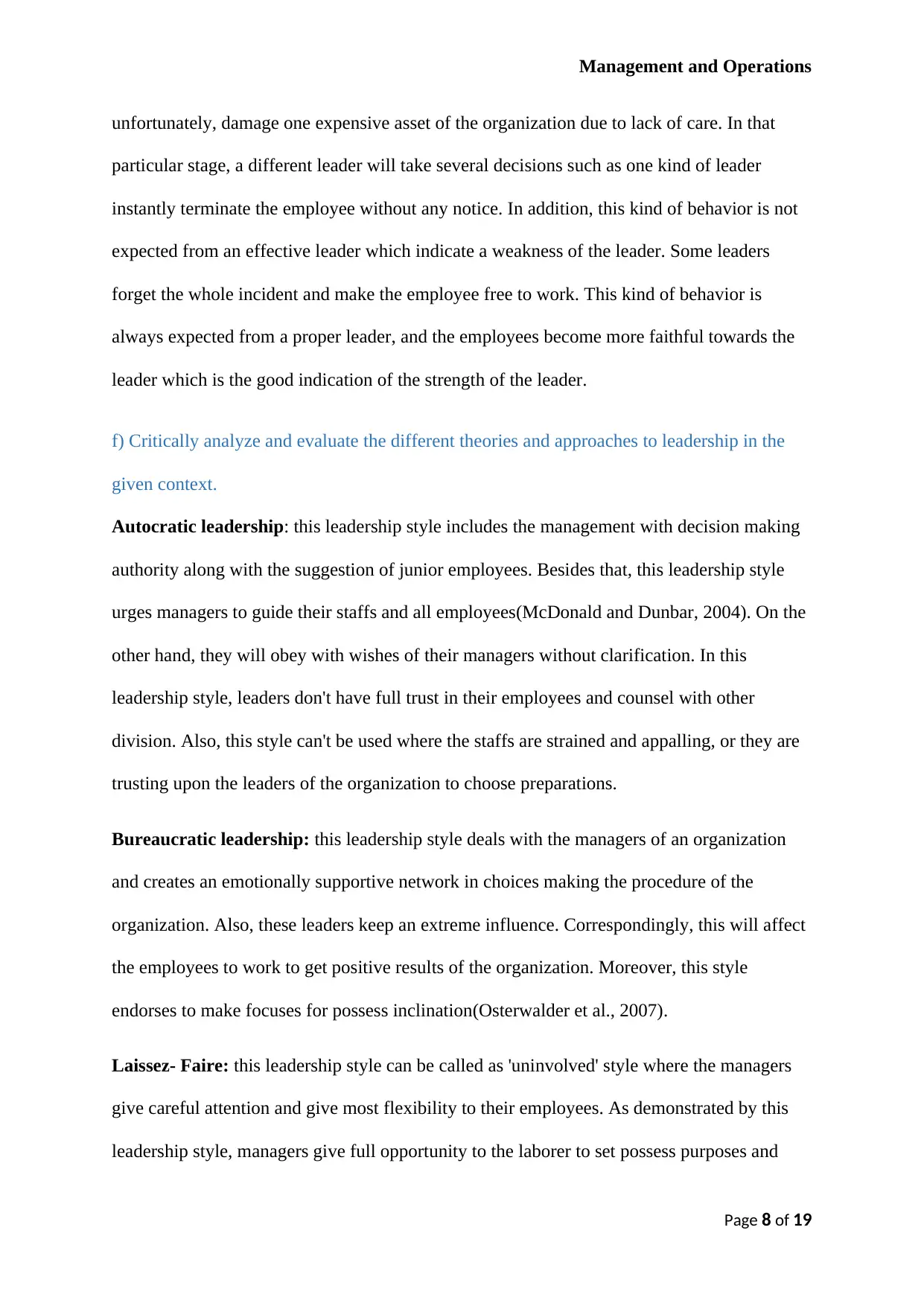
Management and Operations
unfortunately, damage one expensive asset of the organization due to lack of care. In that
particular stage, a different leader will take several decisions such as one kind of leader
instantly terminate the employee without any notice. In addition, this kind of behavior is not
expected from an effective leader which indicate a weakness of the leader. Some leaders
forget the whole incident and make the employee free to work. This kind of behavior is
always expected from a proper leader, and the employees become more faithful towards the
leader which is the good indication of the strength of the leader.
f) Critically analyze and evaluate the different theories and approaches to leadership in the
given context.
Autocratic leadership: this leadership style includes the management with decision making
authority along with the suggestion of junior employees. Besides that, this leadership style
urges managers to guide their staffs and all employees(McDonald and Dunbar, 2004). On the
other hand, they will obey with wishes of their managers without clarification. In this
leadership style, leaders don't have full trust in their employees and counsel with other
division. Also, this style can't be used where the staffs are strained and appalling, or they are
trusting upon the leaders of the organization to choose preparations.
Bureaucratic leadership: this leadership style deals with the managers of an organization
and creates an emotionally supportive network in choices making the procedure of the
organization. Also, these leaders keep an extreme influence. Correspondingly, this will affect
the employees to work to get positive results of the organization. Moreover, this style
endorses to make focuses for possess inclination(Osterwalder et al., 2007).
Laissez- Faire: this leadership style can be called as 'uninvolved' style where the managers
give careful attention and give most flexibility to their employees. As demonstrated by this
leadership style, managers give full opportunity to the laborer to set possess purposes and
Page 8 of 19
unfortunately, damage one expensive asset of the organization due to lack of care. In that
particular stage, a different leader will take several decisions such as one kind of leader
instantly terminate the employee without any notice. In addition, this kind of behavior is not
expected from an effective leader which indicate a weakness of the leader. Some leaders
forget the whole incident and make the employee free to work. This kind of behavior is
always expected from a proper leader, and the employees become more faithful towards the
leader which is the good indication of the strength of the leader.
f) Critically analyze and evaluate the different theories and approaches to leadership in the
given context.
Autocratic leadership: this leadership style includes the management with decision making
authority along with the suggestion of junior employees. Besides that, this leadership style
urges managers to guide their staffs and all employees(McDonald and Dunbar, 2004). On the
other hand, they will obey with wishes of their managers without clarification. In this
leadership style, leaders don't have full trust in their employees and counsel with other
division. Also, this style can't be used where the staffs are strained and appalling, or they are
trusting upon the leaders of the organization to choose preparations.
Bureaucratic leadership: this leadership style deals with the managers of an organization
and creates an emotionally supportive network in choices making the procedure of the
organization. Also, these leaders keep an extreme influence. Correspondingly, this will affect
the employees to work to get positive results of the organization. Moreover, this style
endorses to make focuses for possess inclination(Osterwalder et al., 2007).
Laissez- Faire: this leadership style can be called as 'uninvolved' style where the managers
give careful attention and give most flexibility to their employees. As demonstrated by this
leadership style, managers give full opportunity to the laborer to set possess purposes and
Page 8 of 19
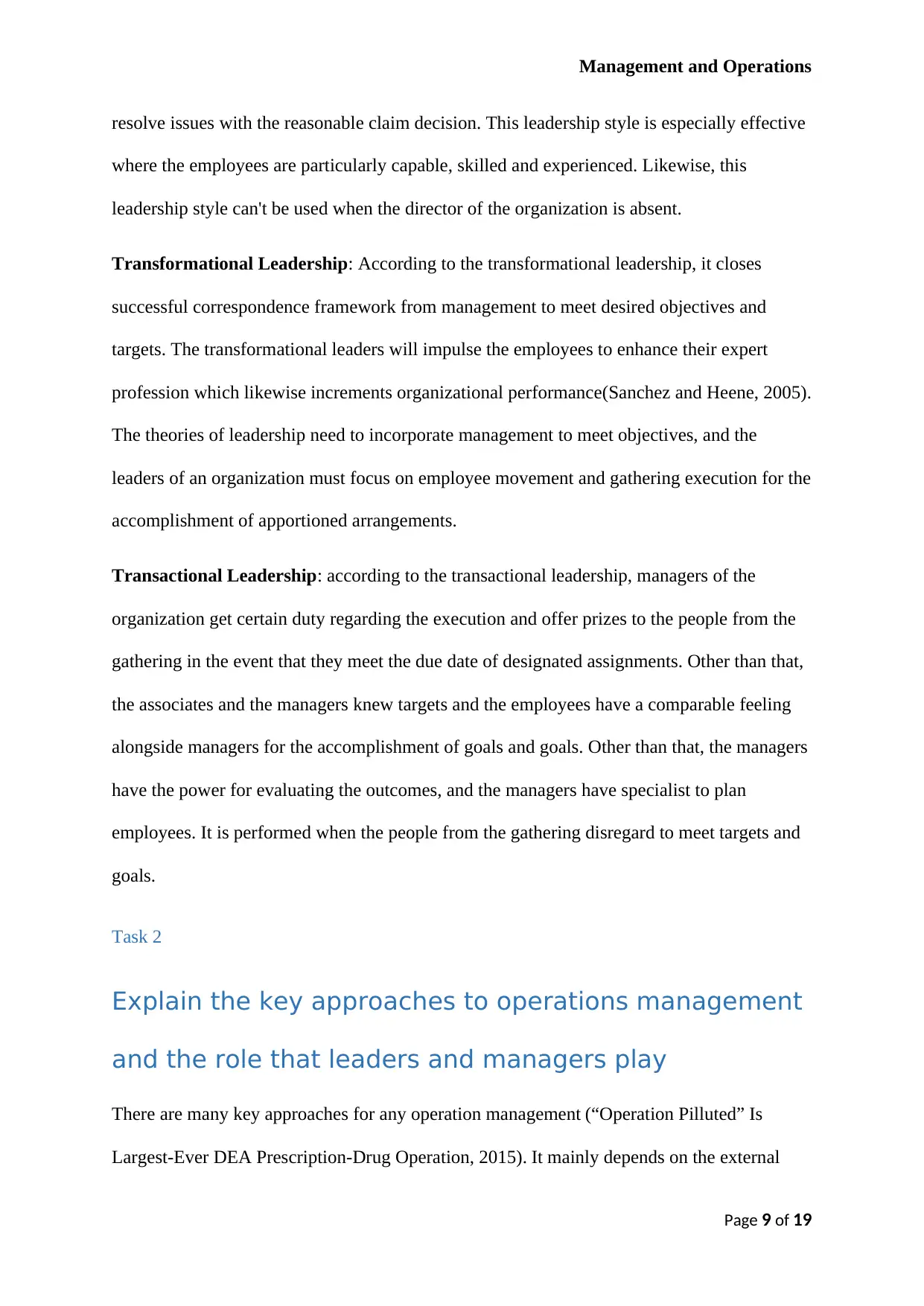
Management and Operations
resolve issues with the reasonable claim decision. This leadership style is especially effective
where the employees are particularly capable, skilled and experienced. Likewise, this
leadership style can't be used when the director of the organization is absent.
Transformational Leadership: According to the transformational leadership, it closes
successful correspondence framework from management to meet desired objectives and
targets. The transformational leaders will impulse the employees to enhance their expert
profession which likewise increments organizational performance(Sanchez and Heene, 2005).
The theories of leadership need to incorporate management to meet objectives, and the
leaders of an organization must focus on employee movement and gathering execution for the
accomplishment of apportioned arrangements.
Transactional Leadership: according to the transactional leadership, managers of the
organization get certain duty regarding the execution and offer prizes to the people from the
gathering in the event that they meet the due date of designated assignments. Other than that,
the associates and the managers knew targets and the employees have a comparable feeling
alongside managers for the accomplishment of goals and goals. Other than that, the managers
have the power for evaluating the outcomes, and the managers have specialist to plan
employees. It is performed when the people from the gathering disregard to meet targets and
goals.
Task 2
Explain the key approaches to operations management
and the role that leaders and managers play
There are many key approaches for any operation management (“Operation Pilluted” Is
Largest-Ever DEA Prescription-Drug Operation, 2015). It mainly depends on the external
Page 9 of 19
resolve issues with the reasonable claim decision. This leadership style is especially effective
where the employees are particularly capable, skilled and experienced. Likewise, this
leadership style can't be used when the director of the organization is absent.
Transformational Leadership: According to the transformational leadership, it closes
successful correspondence framework from management to meet desired objectives and
targets. The transformational leaders will impulse the employees to enhance their expert
profession which likewise increments organizational performance(Sanchez and Heene, 2005).
The theories of leadership need to incorporate management to meet objectives, and the
leaders of an organization must focus on employee movement and gathering execution for the
accomplishment of apportioned arrangements.
Transactional Leadership: according to the transactional leadership, managers of the
organization get certain duty regarding the execution and offer prizes to the people from the
gathering in the event that they meet the due date of designated assignments. Other than that,
the associates and the managers knew targets and the employees have a comparable feeling
alongside managers for the accomplishment of goals and goals. Other than that, the managers
have the power for evaluating the outcomes, and the managers have specialist to plan
employees. It is performed when the people from the gathering disregard to meet targets and
goals.
Task 2
Explain the key approaches to operations management
and the role that leaders and managers play
There are many key approaches for any operation management (“Operation Pilluted” Is
Largest-Ever DEA Prescription-Drug Operation, 2015). It mainly depends on the external
Page 9 of 19
⊘ This is a preview!⊘
Do you want full access?
Subscribe today to unlock all pages.

Trusted by 1+ million students worldwide
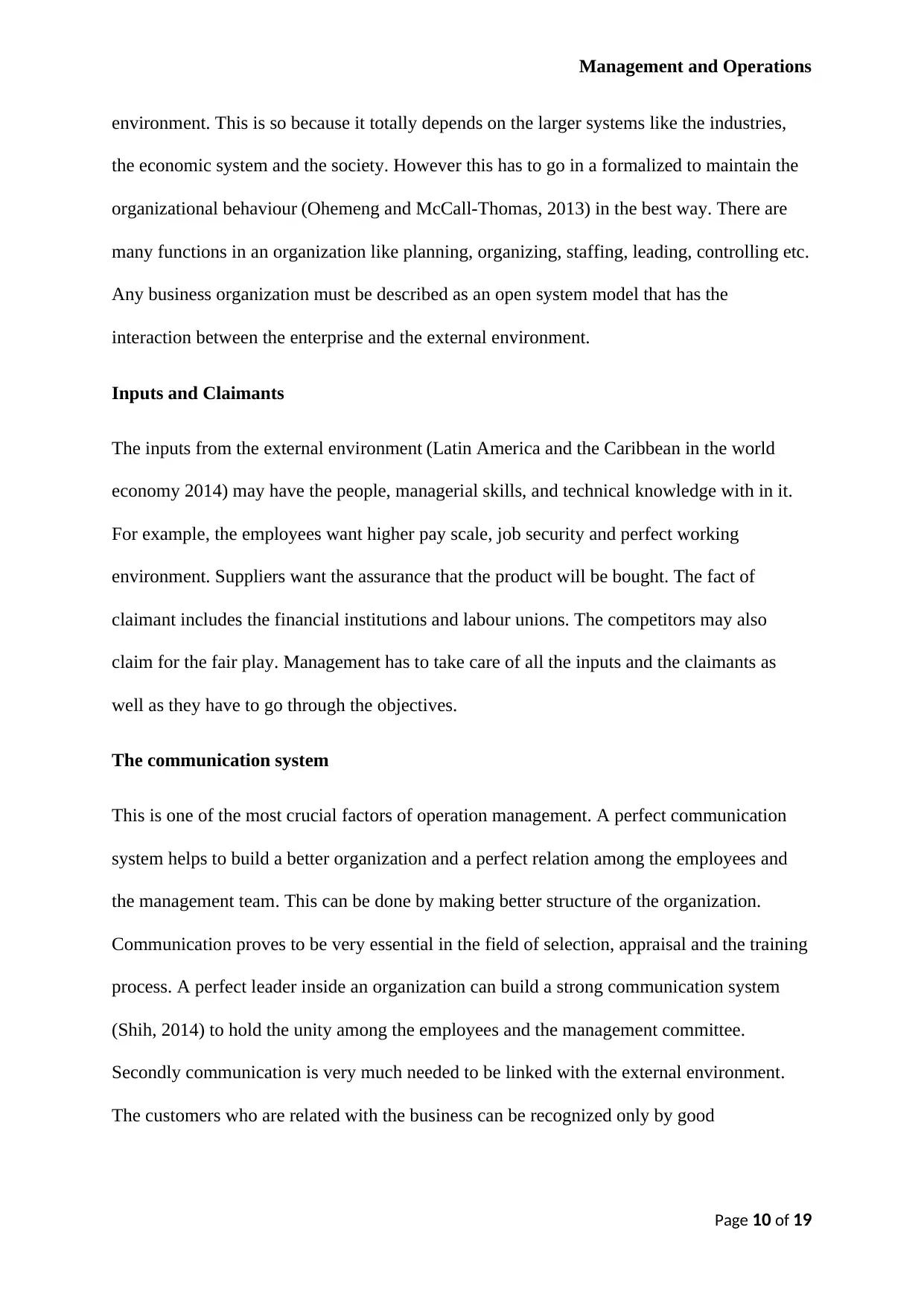
Management and Operations
environment. This is so because it totally depends on the larger systems like the industries,
the economic system and the society. However this has to go in a formalized to maintain the
organizational behaviour (Ohemeng and McCall-Thomas, 2013) in the best way. There are
many functions in an organization like planning, organizing, staffing, leading, controlling etc.
Any business organization must be described as an open system model that has the
interaction between the enterprise and the external environment.
Inputs and Claimants
The inputs from the external environment (Latin America and the Caribbean in the world
economy 2014) may have the people, managerial skills, and technical knowledge with in it.
For example, the employees want higher pay scale, job security and perfect working
environment. Suppliers want the assurance that the product will be bought. The fact of
claimant includes the financial institutions and labour unions. The competitors may also
claim for the fair play. Management has to take care of all the inputs and the claimants as
well as they have to go through the objectives.
The communication system
This is one of the most crucial factors of operation management. A perfect communication
system helps to build a better organization and a perfect relation among the employees and
the management team. This can be done by making better structure of the organization.
Communication proves to be very essential in the field of selection, appraisal and the training
process. A perfect leader inside an organization can build a strong communication system
(Shih, 2014) to hold the unity among the employees and the management committee.
Secondly communication is very much needed to be linked with the external environment.
The customers who are related with the business can be recognized only by good
Page 10 of 19
environment. This is so because it totally depends on the larger systems like the industries,
the economic system and the society. However this has to go in a formalized to maintain the
organizational behaviour (Ohemeng and McCall-Thomas, 2013) in the best way. There are
many functions in an organization like planning, organizing, staffing, leading, controlling etc.
Any business organization must be described as an open system model that has the
interaction between the enterprise and the external environment.
Inputs and Claimants
The inputs from the external environment (Latin America and the Caribbean in the world
economy 2014) may have the people, managerial skills, and technical knowledge with in it.
For example, the employees want higher pay scale, job security and perfect working
environment. Suppliers want the assurance that the product will be bought. The fact of
claimant includes the financial institutions and labour unions. The competitors may also
claim for the fair play. Management has to take care of all the inputs and the claimants as
well as they have to go through the objectives.
The communication system
This is one of the most crucial factors of operation management. A perfect communication
system helps to build a better organization and a perfect relation among the employees and
the management team. This can be done by making better structure of the organization.
Communication proves to be very essential in the field of selection, appraisal and the training
process. A perfect leader inside an organization can build a strong communication system
(Shih, 2014) to hold the unity among the employees and the management committee.
Secondly communication is very much needed to be linked with the external environment.
The customers who are related with the business can be recognized only by good
Page 10 of 19
Paraphrase This Document
Need a fresh take? Get an instant paraphrase of this document with our AI Paraphraser
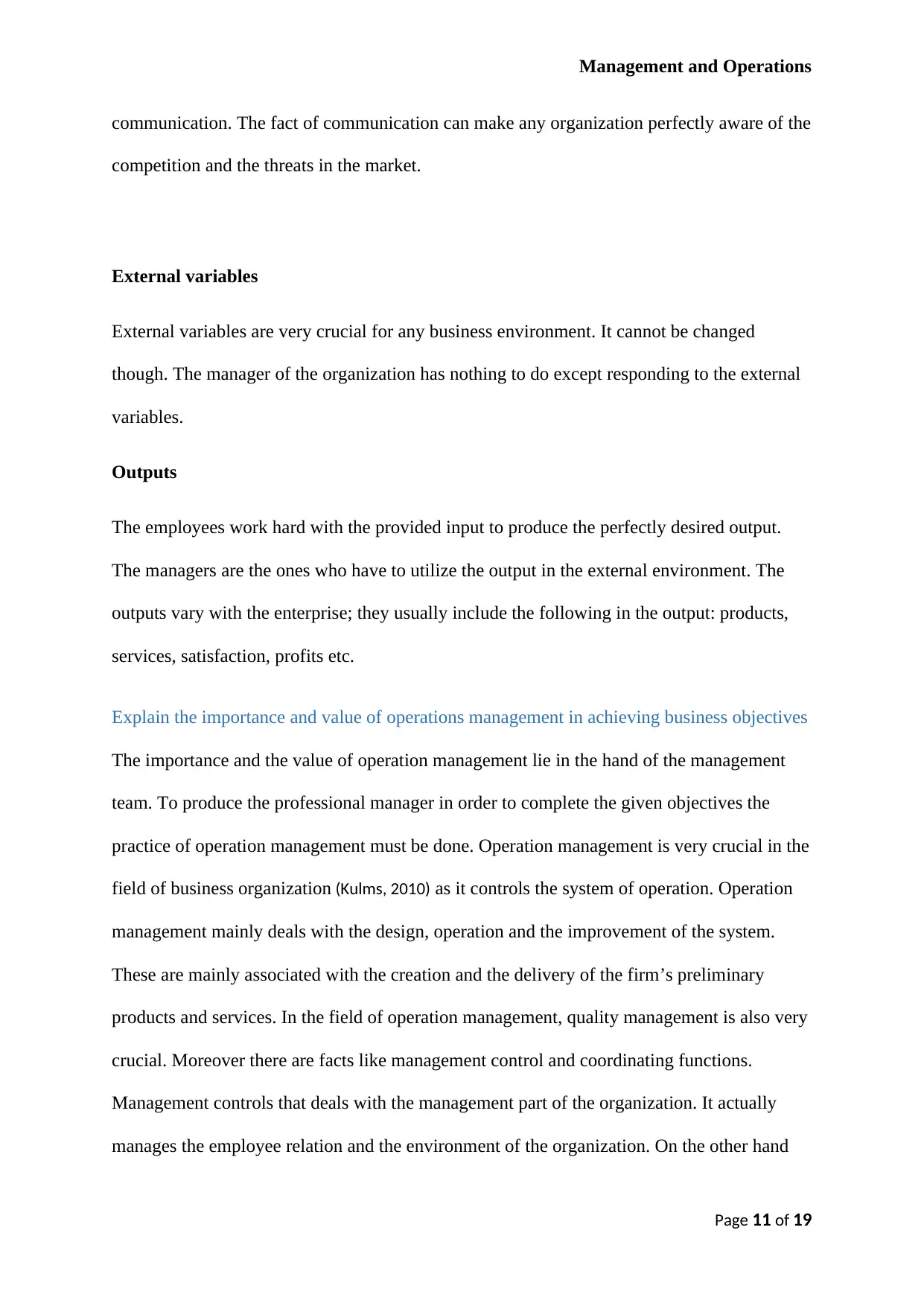
Management and Operations
communication. The fact of communication can make any organization perfectly aware of the
competition and the threats in the market.
External variables
External variables are very crucial for any business environment. It cannot be changed
though. The manager of the organization has nothing to do except responding to the external
variables.
Outputs
The employees work hard with the provided input to produce the perfectly desired output.
The managers are the ones who have to utilize the output in the external environment. The
outputs vary with the enterprise; they usually include the following in the output: products,
services, satisfaction, profits etc.
Explain the importance and value of operations management in achieving business objectives
The importance and the value of operation management lie in the hand of the management
team. To produce the professional manager in order to complete the given objectives the
practice of operation management must be done. Operation management is very crucial in the
field of business organization (Kulms, 2010) as it controls the system of operation. Operation
management mainly deals with the design, operation and the improvement of the system.
These are mainly associated with the creation and the delivery of the firm’s preliminary
products and services. In the field of operation management, quality management is also very
crucial. Moreover there are facts like management control and coordinating functions.
Management controls that deals with the management part of the organization. It actually
manages the employee relation and the environment of the organization. On the other hand
Page 11 of 19
communication. The fact of communication can make any organization perfectly aware of the
competition and the threats in the market.
External variables
External variables are very crucial for any business environment. It cannot be changed
though. The manager of the organization has nothing to do except responding to the external
variables.
Outputs
The employees work hard with the provided input to produce the perfectly desired output.
The managers are the ones who have to utilize the output in the external environment. The
outputs vary with the enterprise; they usually include the following in the output: products,
services, satisfaction, profits etc.
Explain the importance and value of operations management in achieving business objectives
The importance and the value of operation management lie in the hand of the management
team. To produce the professional manager in order to complete the given objectives the
practice of operation management must be done. Operation management is very crucial in the
field of business organization (Kulms, 2010) as it controls the system of operation. Operation
management mainly deals with the design, operation and the improvement of the system.
These are mainly associated with the creation and the delivery of the firm’s preliminary
products and services. In the field of operation management, quality management is also very
crucial. Moreover there are facts like management control and coordinating functions.
Management controls that deals with the management part of the organization. It actually
manages the employee relation and the environment of the organization. On the other hand
Page 11 of 19
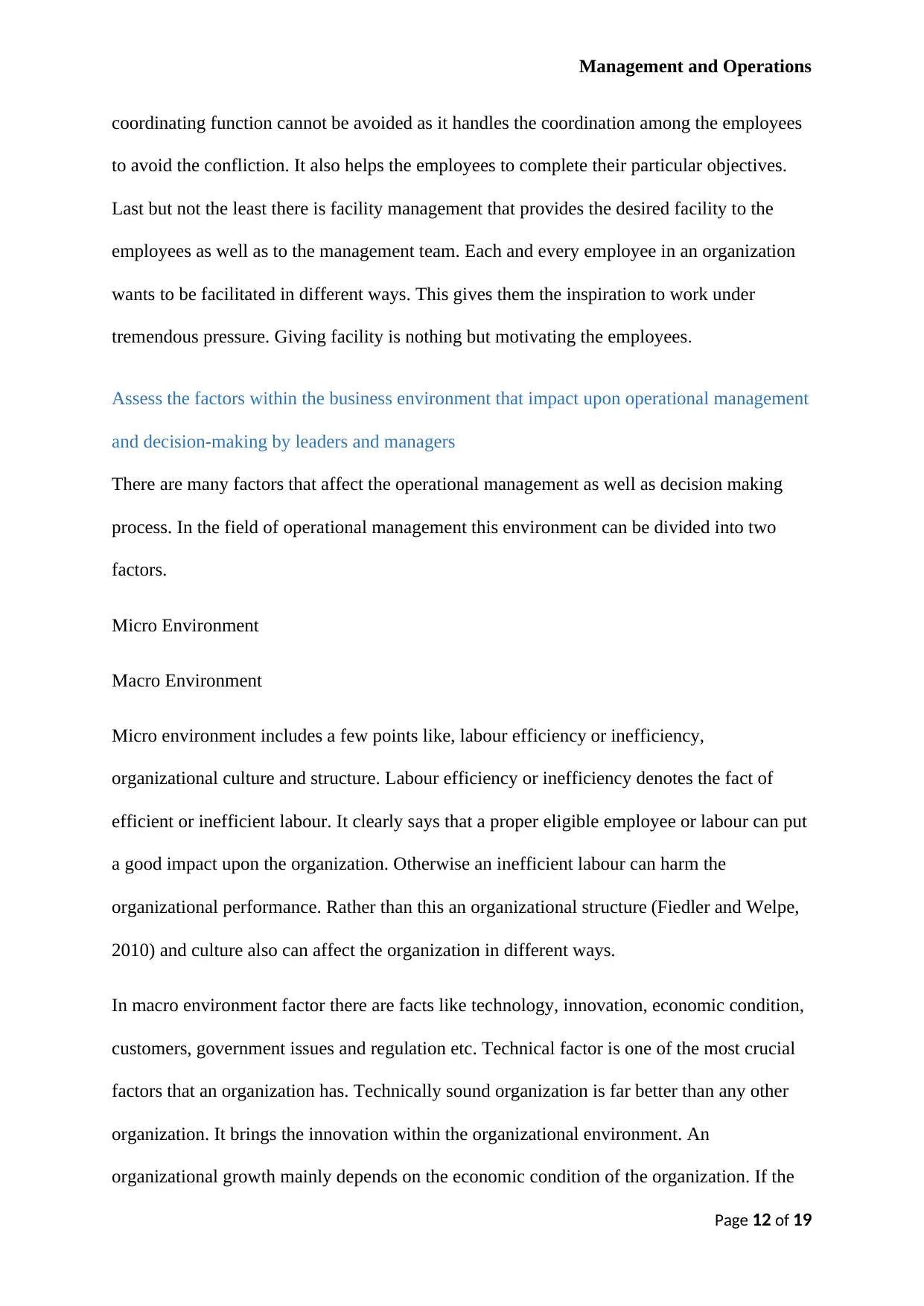
Management and Operations
coordinating function cannot be avoided as it handles the coordination among the employees
to avoid the confliction. It also helps the employees to complete their particular objectives.
Last but not the least there is facility management that provides the desired facility to the
employees as well as to the management team. Each and every employee in an organization
wants to be facilitated in different ways. This gives them the inspiration to work under
tremendous pressure. Giving facility is nothing but motivating the employees.
Assess the factors within the business environment that impact upon operational management
and decision-making by leaders and managers
There are many factors that affect the operational management as well as decision making
process. In the field of operational management this environment can be divided into two
factors.
Micro Environment
Macro Environment
Micro environment includes a few points like, labour efficiency or inefficiency,
organizational culture and structure. Labour efficiency or inefficiency denotes the fact of
efficient or inefficient labour. It clearly says that a proper eligible employee or labour can put
a good impact upon the organization. Otherwise an inefficient labour can harm the
organizational performance. Rather than this an organizational structure (Fiedler and Welpe,
2010) and culture also can affect the organization in different ways.
In macro environment factor there are facts like technology, innovation, economic condition,
customers, government issues and regulation etc. Technical factor is one of the most crucial
factors that an organization has. Technically sound organization is far better than any other
organization. It brings the innovation within the organizational environment. An
organizational growth mainly depends on the economic condition of the organization. If the
Page 12 of 19
coordinating function cannot be avoided as it handles the coordination among the employees
to avoid the confliction. It also helps the employees to complete their particular objectives.
Last but not the least there is facility management that provides the desired facility to the
employees as well as to the management team. Each and every employee in an organization
wants to be facilitated in different ways. This gives them the inspiration to work under
tremendous pressure. Giving facility is nothing but motivating the employees.
Assess the factors within the business environment that impact upon operational management
and decision-making by leaders and managers
There are many factors that affect the operational management as well as decision making
process. In the field of operational management this environment can be divided into two
factors.
Micro Environment
Macro Environment
Micro environment includes a few points like, labour efficiency or inefficiency,
organizational culture and structure. Labour efficiency or inefficiency denotes the fact of
efficient or inefficient labour. It clearly says that a proper eligible employee or labour can put
a good impact upon the organization. Otherwise an inefficient labour can harm the
organizational performance. Rather than this an organizational structure (Fiedler and Welpe,
2010) and culture also can affect the organization in different ways.
In macro environment factor there are facts like technology, innovation, economic condition,
customers, government issues and regulation etc. Technical factor is one of the most crucial
factors that an organization has. Technically sound organization is far better than any other
organization. It brings the innovation within the organizational environment. An
organizational growth mainly depends on the economic condition of the organization. If the
Page 12 of 19
⊘ This is a preview!⊘
Do you want full access?
Subscribe today to unlock all pages.

Trusted by 1+ million students worldwide
1 out of 19
Related Documents
Your All-in-One AI-Powered Toolkit for Academic Success.
+13062052269
info@desklib.com
Available 24*7 on WhatsApp / Email
![[object Object]](/_next/static/media/star-bottom.7253800d.svg)
Unlock your academic potential
Copyright © 2020–2025 A2Z Services. All Rights Reserved. Developed and managed by ZUCOL.





